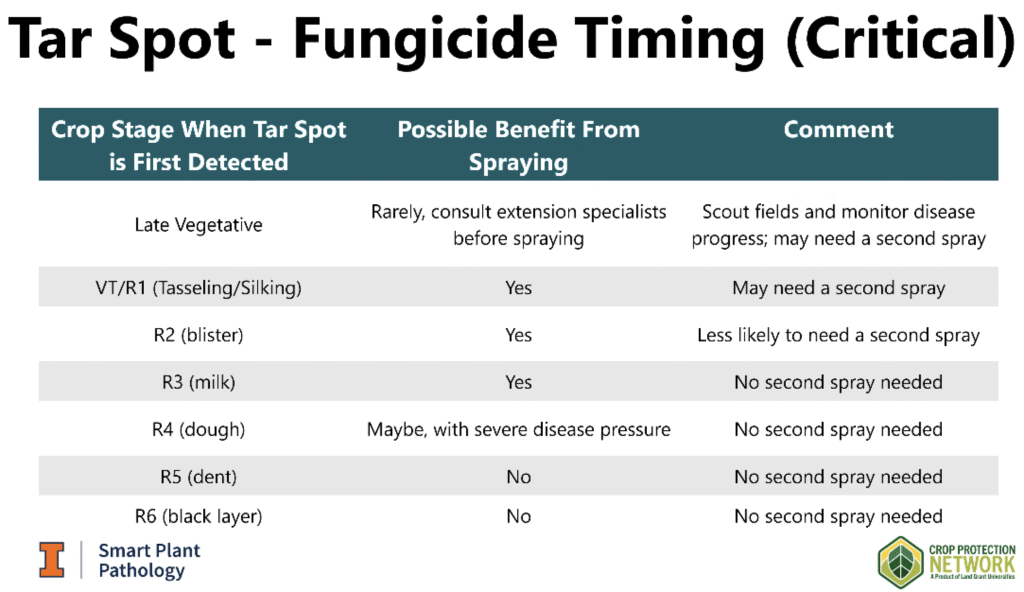An Illinois Crop Progress Conversation
* Tools to Manage Tar Spot
* Illinois Soft Red Winter Wheat Harvest & Quality
* Corn and Soybean Update
* WILLAg Closing Market Report and Commodity Week
The Closing Market Report podcast player should open to the spot where the Illinois Field Crops discussion begins, or about six minutes into the program.
Tools to Manage Tar Spot
There is a new online tool farmers and retailers may use to help track, manage, and treat insect pests and diseases of field crops. The Crop Protection Network is a product of Land Grant Universities for farmers in the United States and Canada, says Boris Camiletti, plant pathologist at the University of Illinois, “So every extension plant pathologist in every state, we all met and created tools for farmers.”
Camiletti uses fungicides as an example. The data from all the field trials were gathered to create efficacy tables and ratings for foliar disease control. He says these include nearly every product available to the marketplace. Those ratings are included on the website. The Land Grant crop scientists also developed a way to track, by county, where insect pests and diseases have been reported.
Crop Lookout is a real-time, interactive map that highlights emerging field crop issues across the United States and Canada. Updated throughout the growing season by university Extension specialists and research partners, the tool visualizes reports of diseases, pests, and other agronomic challenges as they develop, helping you stay informed and ahead of the curve.
 The crop disease forecasting tool analyzes local weather conditions to show the likelihood of foliar disease development.
The crop disease forecasting tool analyzes local weather conditions to show the likelihood of foliar disease development.
The second tool on the Crop Protection Network website is what makes it valuable. The Crop Disease Forecasting page uses site-specific weather data to predict past and future foliar disease developments. Camiletti says it is designed to complement field scouting, “It’s still really important to scout the fields to see if you have the disease, and more importantly, to see if the disease is progressing over time”.
Using a combination of the website’s tools, a producer can see if a disease has been reported in their area, if conditions have or will be good for it to develop, and make a field crop scouting treatment decision using university recommendations.
 University of Illinois Tar Spot fungicide applications timing table
University of Illinois Tar Spot fungicide applications timing table
—
Wheat, Corn, and Soybean
Soft Red Winter Wheat harvest in the state of Illinois as of June 30 was running just behind the five-year average, but given clear weather conditions this past week should be progressing nicely. University of Illinois agronomist John Jones says the field trials he’s been monitoring in the state have been impressive. This is especially the case because of the expected amount of disease pressure during a wet spring. Jones says some of the higher yields are well above 100 bushels to the acre, “Even up to mid to high 120s in terms of yield. The quality has been pretty good, too, with test weights well above 60 pounds in some cases”.
Jones thinks the second crop soybeans sown into wheat stubble should be off to a good start. He expects emergence to go well given some timely rainfall.
There are, however, places in the state that remain dry as you move through central and northern Illinois. Jones noted a lack of moisture when soil sampling this week. Nitrogen availability is tied to how well water moves through the soil profile. Rainfall over the coming few weeks would help the corn crop during peak water uptake as it moves through tasseling and pollination.
The soil fertility specialist says he has been getting some questions about iron deficiency chlorosis in soybean. He has confirmed some fields with an appreciable amount of carbonate in the soil surface, “So if that is the case, there are some options. Your best option is really variety selection”.
Usually, says Jones, iron products have an ability to green up tissue, but this rarely translates to yield response. Iron deficiency, then, is best managed at the beginning of the cropping year by choosing varieties that have good IDC or Iron Deficiency Chlorosis scores.
—
WILLAg.org radio programming for the work week ending July 03, 2025
Commodity Week can be heard in the 2 o’clock hour central time on WILL AM580 or you may subscribe to it using the links in the player below. This week the panelists include Matt Bennett with AgMarket.net, Chip Nellinger of BlueReef.ag, and Arlan Suderman at StoneX.com.
The Closing Market Report airs at 2:06 p.m. central daily on WILL AM580. It, too, is a podcast. Subscribe using the link in the player.





